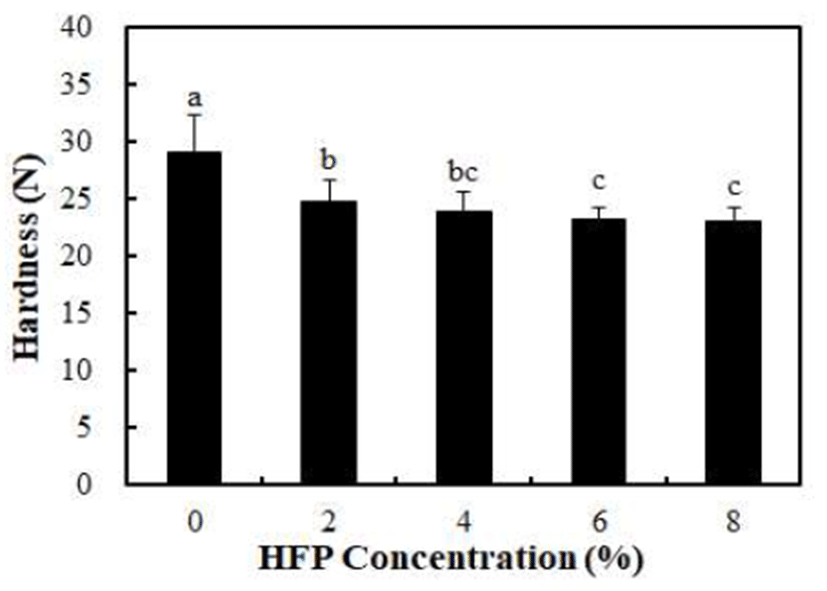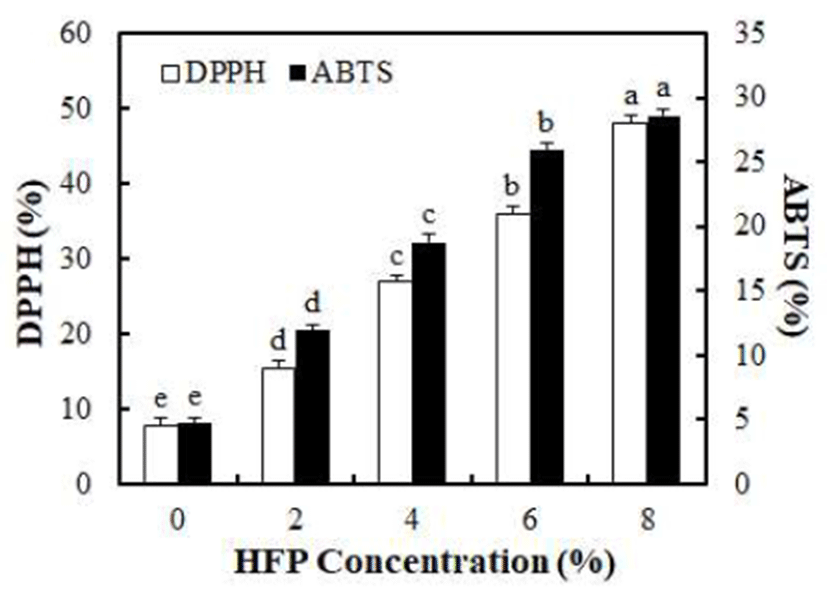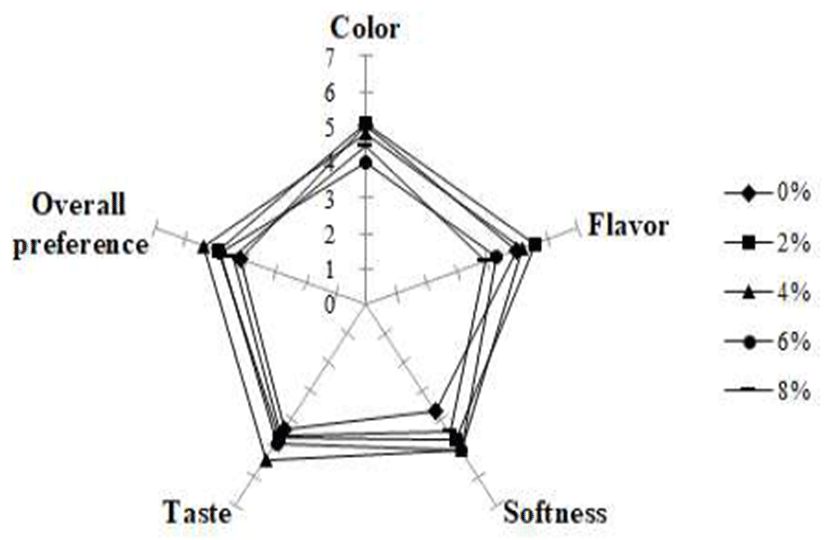Introduction
Hovenia dulcis Thunb., belongs to Rhamnaceae family, is a deciduous tree native to East Asia and found in Korea, China, Japan, and Himalayas (1,2). These fruits have long been used in traditional folk remedies to relieve the symptoms of hangover (3) and for treatments of liver diseases (4) and alcoholic detoxification (5). Furthermore, it has been reported to posses anti-oxidative, hepatoprotective (1,6), anti-inflammatory (7), and immunostimulatory activities (8).
Bakery products are widely accepted and consumed in large quantities all over the world (9); thus, they can offer a convenient supplementation vehicle for nutritional improvement (10). The behavior and eating habits have changed continually and demand for health-oriented products is increasing. Thus, development of new types of ready-to-eat convenience foods that provide health benefits is of great importance. With this respect, cookies have been suggested as a good way to use composite flours, and provide a good source of energy (11).
Above-mentioned rapidly growing concerns about healthy diets and increased demand for the use of new natural food ingredients, especially in cookies, have led us to investigate wheat-based products with value-added ingredients. Over the years, a number of studies have been reported on improved nutritive value of cookies incorporated with various types of powder replacing the wheat flour. So far, research on the incorporation of such powder or flour for manufacturing of cookies has focused on powders of Oddi (12), cherry fruit (13), acorn (14), purple kohlrabi (15), acaiberry (16), and Takju pomace (17) to name a few. However, there is little information on the incorporation of Hovenia dulcis fruit powder (HFP) in cookies.
The objectives of this research were to make cookies with 0%, 2%, 4%, 6%, and 8% HFP substituted for wheat flour in order to evaluate the effects of HFP on cookie qualities and consumer acceptances as a result of supplementation. The antioxidant properties of cookies were also determined.
Materials and Methods
HFP was procured from Garunara (Garunara, Seoul, Korea), and wheat flour (soft flour, CJ Cheiljedang, Yangsan, Korea), white sugar (CJ Cheiljedang, Seoul, Korea), salt-free butter (Seoul Milk Coop., Yongin, Korea), and eggs were purchased from a local market.
The standard cookies’ recipe consisted of 200 g (100%) of flour (white wheat flour as a control), 100 g salt-free butter, 90 g white granulated sugar, and 50 g egg. The composite flour cookies were prepared from various combinations of wheat flour, and HFP in ratio of 100:0, 98:2, 96:4, 94:6, and 92:8, respectively. Butter, sugar, and eggs were creamed with a kitchen mixer (5K5SS, KitchenAid Inc., St. Joseph, MI, USA) at speed 2 for 3 min with scraping down every minute. Wheat flour and appropriate amount of HFP were then added and mixed at speed 1 for 3 min. Dough was placed in a 4℃ refrigerator for 30 min before sheeting. To prepare cookies, the dough was slightly flattened with palm of the hand, sheeted with a roller (gap width 4 mm). Cookie dough was cut with a circular cookie cutter (inside diameter 5 cm) and dough pieces were placed on a baking tray with baking paper and baked at 170℃ for 10 min in a preheated oven (KXS-4G+H, Salvia industrial S.A., Lezo, Spain). Baked cookies were removed from the oven cooled down for 1 h, weighed, packed in sealed plastic bags and stored for 24 h at ambient temperature before analyses were conducted. The test cookie samples prepared with 0%, 2%, 4%, 6%, and 8% HFP substituted for wheat flour were designated as the control, HFP2, HFP4, HFP6, and HFP8, respectively.
A dough sample (5 g) was mixed with 45 mL of distilled water and vortexed for 1 min. The mixture was held at ambient temperature for 1 h in order to separate solid and liquid phases. The pH of the supernatant was measured using a pH meter (pH/Ion 510, Oakton Instruments, Vernon Hills, IL, USA). Dough density measurements were performed in a 50 mL mass cylinder by water displacement.
Moisture content was obtained by drying a specific amount (5 g) of dough sample to a constant weight at 105℃ in an oven (FOL-2, Jeio Tech Co., Daejeon, Korea), and the results were reported on a wet basis (w.b.).
Cookie spread factor was determined according to the AACC Method 10-50D (18). Diameter of control and HFP supplemented cookies was measured with the help of a caliper by laying down six cookies edge to edge. The diameter of six cookies was measured again after rotating each cookie to 90° and then the average value of cookie diameter was calculated. Six cookies were stacked on each other and their thickness was measured. Cookies were restacked in random order and thickness was measured again and then the average value of cookie thickness was calculated. Spread factor of cookies was measured from the ratio of average value of diameter and average value of thickness of cookies.
Hardness of the cookies was measured using a texture analyzer (LRXPlus, Lloyd Instrument Limited, Fareham, Hampshire, UK) in a compression mode via 3-point bending test using 3-point bending rig, trigger force of 0.049 N, and load cell of 100 N. The textural studies were conducted at test speed of 1.0 mm/s, distance 10 mm and the distance between the two bottom supports was adjusted to 40 mm. The peak value of fracture force (maximum) was recorded as hardness at a point when the cookies were broken into two major pieces (19). The peak force to snap the cookies was reported as fracture force in ‘N’.
The surface color of the cookies was measured using a Chromameter (CM-600d, Minolta Co., Osaka, Japan) set for CIELAB color space. CIELAB indicates color values with three axes: L*, a*, and b*. The central vertical axis represents lightness (L*) whose values vary from 0 (black) to 100 (white). On the a-a' axis, positive values indicate amounts of red while negative values indicate amounts of green. On the b-b' axis, yellow is positive and blue is negative. For both axes, zero is neutral gray (20).
DPPH radical scavenging activities of the samples were measured in terms of their hydrogen donating or radical scavenging activity using stable DPPH radical. The assay was performed as previously described by Blois (21) with some modifications. Briefly, 0.15 mM solution of DPPH radical in ethanol was prepared, after which 5 mL of this solution was added to 1 mL of sample solution in ethanol at different concentrations and then shaken and left to stand for 10 min. Decolorization of DPPH-donated protons was determined by measuring the absorbance at 517 nm using a spectrophotometer (Optizen 2020 UV Plus, Mecasys Co., Ltd., Daejeon, Korea). The scavenging activity of DPPH radical was calculated using the following equation:
The spectrophotometric analysis of ABTS+․ radical scavenging activity was determined according to the method used by Re et al. (22) with slight modifications. The ABTS+․ cation radical was produced by a reaction between 7.4 mM ABTS in H2O and 2.6 mM potassium persulfate during storage in the dark at room temperature for 12 h. Before use, ABTS+․ solution was diluted with methanol to obtain an absorbance of 1.1 at 734 nm. Subsequently, 3 mL of ABTS+․ solution was added to 0.1 mL of sample. After 10 min, the percent inhibition at 734 nm was calculated for each concentration relative to blank absorbance.
Cookies made from wheat (control) and different amounts of HFP were subjected to sensory evaluation using fifty (50) untrained volunteer consumers (25 males and 25 females, aged from 20 to 27), drawn from the Department of Food Engineering. Panelists received a tray containing five samples presented in random order at room temperature (randomly coded using a three-digit number), a glass of water, and an evaluation sheet. Participants were instructed on how to evaluate the samples, and were not required to expectorate or consume the entire volume served. Panelist were asked to evaluate for consumer acceptance of color, flavor, softness, taste, and overall acceptance. The ratings were carried on a 7-point Hedonic scale ranging from 7 (like extremely) to 1 (dislike extremely). Orders of serving were completely randomized.
Overall acceptance was evaluated first, and another session was held to evaluate the rest of the attributes. There was an inter-stimulus interval of 30 s imposed between samples, to allow time to recover from adaptation. Participants were advised to rinse their palates between samples. Enough space was given to handle the samples and questionnaire, and evaluation time was not constrained. No specific compensation was given to the participants.
This study was approved by the Daegu University Institutional Review Board (IRB# 1040621-201703-HR- 014-02).
Each measurement was conducted triplicate, except for moisture content (n=5), color (n=5), hardness (n=24), and sensory evaluation (n=50). The experimental data were subjected to an analysis of variance (ANOVA) using the general linear models (GLM) procedure to identify significant differences among the samples. Mean values were compared using Duncan’s multiple range test. The significance was defined at the 5% level.
Results and Discussion
Table 1 describes the physicochemical characterization of cookie dough supplemented with different levels of HFP. The pH ranged from 5.80 to 6.34 and significantly decreased upon addition of HFP (p<0.05). Nevertheless, only minor changes were observed. Thus, it seems that HFP supplementation could result in the production of cookies with slightly lower pH. Similar reduction of pH was observed for cookie doughs incorporated with acorn powder (14) and purple kohlrabi powder (15) probably due to the weak acidic nature of powder supplemented. The pH of HFP was 5.44 in this study.
| Property | HFP level (%) | ||||
|---|---|---|---|---|---|
| 0 | 2 | 4 | 6 | 8 | |
| pH | 6.34±0.03a1) | 6.20±0.04b | 6.12±0.04c | 5.95±0.07d | 5.80±0.03e |
| Density (kg/L) | 1.21±0.03a | 1.14±0.03b | 1.12±0.04b | 1.09±0.04b | 1.08±0.05b |
Density of cookie dough appeared to decrease upon addition of HFP; however, no significant differences were found among HFP2, HFP4, HFP6, and HFP8 samples (p>0.05) and only density of the control was significantly higher than others (p<0.05). This is probably due to the fact that substitution of wheat flour with HFP which contains less amount of protein led to decrease in the density of cookie dough (23). Similar reduction of dough density has been observed with cookie dough incorporated with purple kohlrabi powder (15).
Table 2 presents the physical characterization of cookies supplemented with different levels of HFP. The moisture content of cookies ranged from 2.33 to 3.64% (w.b.) and significantly increased upon addition of HFP (p<0.05). This can be explained by an affinity effect between HFP sample and moisture (24). This would increase the moisture content of cookies with higher amount of HFP. A similar trend was also reported for cookies supplemented with acorn powder (14) and cranberry powder (25).
As the substitution level of white wheat flour increased, the spread factor increased significantly from 8.05 to 9.31 (p<0.05). The spread factor is an important characteristic in determining the quality of cookies (26). Similar results were reported for the cookies containing 2-6% potato flour (27). The substitution with HFP might induce the reduction of dough viscosity (28). Thus, the spread factor, which is inversely correlated to the dough viscosity (29), was increased. The increase in spread factor by adding HFP in this study could be attributed to the decrease in total gluten content and also the increase in protein content (30). It was also reported that the spread ratio increased as non-wheat protein content increased (27). Non-wheat protein exhibited greater water retentions than gluten, resulting in affecting cookie spread during baking (31).
The hardness of the cookies containing FHP was significantly (p<0.05) lower than that made from white wheat flour (Fig. 1). Increased levels of FHP thus remarkably decreased the cookies’ hardness ranging from 29.14 N at 0% of replacement to 22.99 N at 8% of substitution. The lower hardness of the cookies prepared from the composite flours containing different amount of FHP could be related to the lower amount of gluten resulted from the reduced white wheat flour in the formulation (32). Accordingly, the hardness of cookies was decreased by adding cherry fruit powder (13), cranberry powder (25), and yacon powder (33).

All color data were expressed as CIELAB L*, a*, and b*-values corresponding to lightness, redness, and yellowness, respectively. It was observed that as the concentration of HFP in the blend increased, the cookies became darker in color as seen in lower L* value of the blends in comparison to control cookies. The highest value of L* was for control sample (72.50) and the lowest value (45.42) was for HFP8 sample, and they were significantly different (p<0.05). Adding HFP resulted in an increase in the redness (a*) but decrease in the yellowness (b*) compared to those of the white wheat flour, which could be attributed to the color changes brought by the HFP replacing the wheat flour. These results were in accordance with the findings reported in cookies supplemented with cherry fruit powder (13), acorn powder (14), and sesame peels flour (28). The Maillard reaction played the major role in color formation in cookies during baking process (34), and starch dextrinization and caramelization which are induced by heating also affected the cookie color (30).
Antioxidant activities were investigated based on DPPH radical scavenging activity and ABTS radical cation assay (Fig. 2). The usage of HFP in the cookie formulation enhanced antioxidant activities, and the effectiveness of antioxidant properties were as follows in ascending order: control < HFP2 < HFP4 < HFP6 < HFP8. Highest DPPH activity was exhibited by cookies containing 8% HFP (48.014%). The results show that HFP supplementation greatly enhanced antioxidant properties of the cookies due to incorporation of phenolic compounds, which have been reported to possess antioxidant activity. ABTS also followed a similar trend to DPPH activity and the data also confirm a positive correlation between two antioxidant capacities. A similar increase was reported in the antioxidant properties of cookies supplemented with cherry fruit powder (13), persimmon leaf powder (35), and flaxseed flour (36). Their antioxidant capacity is based on the breaking of the free radical chain reaction by donating a hydrogen atom, and preventing peroxide formation (37).

Color, flavor, softness, taste, and overall acceptance of control cookie and HFP-supplemented cookies were evaluated, and the results are presented as a radar plot (Fig. 3). When evaluated by untrained panelists, statistically significant differences among samples were detected in terms of all attributes tested (p<0.05). The sensory panelists rated HFP2 with the highest score for color and flavor but it was not significantly different from control and HFP4 (p>0.05). Softness preference score for control was significantly lower (p<0.05) than all other samples which were not significantly different among them (p>0.05). HFP4 received the highest preference scores in terms of taste and overall acceptance (p<0.05). Excessive addition of 8% HFP seemed to have a deteriorative effect on most sensory attributes evaluated. On a seven-point hedonic scale, HFP4 received scores in the range of 4.84-5.40. Considering HFP4 received the highest overall acceptance score of 5.36, partial replacement of 4% HFP in cookie formulation seems satisfactory. In a study reported by Choi and Park (38), it was observed that Hovenia dulcis Composite Flour can be incorporated in noodle as a partial replacement up to 3% of wheat flour without any change of the physical and sensory quality.
